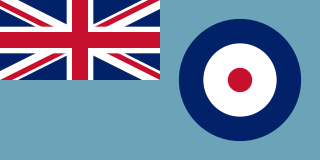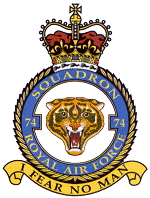
The Desert Air Force (DAF), also known chronologically as Air Headquarters Western Desert, Air Headquarters Libya, the Western Desert Air Force, and the First Tactical Air Force (1TAF), was an Allied tactical air force created from No. 204 Group RAF under RAF Middle East Command in North Africa in 1941 to provide close air support to the British Eighth Army against Axis forces. Throughout the Second World War, the DAF was made up of squadrons from the Royal Air Force (RAF), the South African Air Force (SAAF), the Royal Australian Air Force (RAAF), the United States Army Air Forces (USAAF) and other Allied air forces.

The former Royal Air Force Far East Air Force, more simply known as RAF Far East Air Force, was the Command organisation that controlled all Royal Air Force assets in the east of Asia. It was originally formed as Air Command, South East Asia in 1943 during the Second World War. In 1946, this was renamed RAF Air Command Far East, and finally Far East Air Force in June 1949.

The Tengah Air Base is a military airbase of the Republic of Singapore Air Force (RSAF) located in the Western Water Catchment, in the western part of Singapore.

Seletar Airport is a civilian international airport serving the north-east region of Singapore. It is located approximately 16 km (9.9 mi) northwest from Changi Airport, the country's main airport, and about 16 km (9.9 mi) north from the main commercial city-centre.

No. 488 Squadron was the name given to two distinct Royal New Zealand Air Force squadrons during the Second World War. Both were formed under Article XV of the Empire Air Training Scheme and served under the operational command of the Royal Air Force.

No. 74 Squadron, also known as 'Tiger Squadron' from its tiger-head motif, was a squadron of the Royal Air Force (RAF). It operated fighter aircraft from 1917 to the 1990s, and then trainer aircraft until its disbandment in 2000. It was the Royal Air Force's member of the NATO Tiger Association from 1961 until the squadron's disbandment, it has since been replaced by No. 230 Squadron.

Number 92 Squadron, also known as No. 92 Squadron and currently as No. 92 Tactics and Training Squadron, of the Royal Air Force is a test and evaluation squadron based at RAF Waddington, Lincolnshire. It was formed as part of the Royal Flying Corps at London Colney as a fighter squadron on 1 September 1917. It deployed to France in July 1918 and saw action for just four months, until the end of the war. During the conflict it flew both air superiority and direct ground support missions. It was disbanded at Eil on 7 August 1919. Reformed on 10 October 1939,at Tangmere Airfield, the unit was supposed to be equipped with medium bombers but in the spring of 1940 it became one of the first RAF units to receive the Supermarine Spitfire, going on to fight in the Battle of Britain.

The Royal Auxiliary Air Force (RAuxAF), formerly the Auxiliary Air Force (AAF), together with the Air Force Reserve, is a component of His Majesty's Reserve Air Forces. It provides a primary reinforcement capability for the regular service, and consists of paid volunteers who give up some of their weekends, evenings and holidays to train at one of a number of squadrons around the United Kingdom. Its current mission is to provide trained personnel in support of the regular RAF.

RMAF Butterworth is an active Air Force Station of the Royal Malaysian Air Force (RMAF) situated 4.5 nautical miles from Butterworth in Penang, Malaysia. It is currently home to the Headquarters Integrated Area Defence System (HQIADS), part of the Five Power Defence Arrangements (FPDA).

George Cecil Unwin, was an officer in the Royal Air Force (RAF) and a flying ace of the Second World War. He is credited with destroying at least 15 German aircraft.

Number 45 Squadron is a flying squadron of the Royal Air Force. The squadron, which was established on 1 March 1916 as part of the Royal Flying Corps, currently provides flying training using Embraer Phenom T1s and operates under the command of No. 3 Flying Training School at RAF Cranwell, Lincolnshire.
Royal Air Force Filton or more simply RAF Filton is a former Royal Flying Corps (RFC) and Royal Air Force (RAF) station located 5 miles (8 km) north of the city centre of Bristol, England.

No. 60 Squadron of the Royal Air Force was formed in 1916 at Gosport. It is currently part of No. 1 Flying Training School based at RAF Shawbury in Shropshire flying the Airbus H135 Juno HT.1.

No. 616 Squadron is an active Reserve unit of the Royal Auxiliary Air Force (RAuxAF) assigned to the RAF ISTAR Force at RAF Waddington. It was originally formed as a unit of the British Auxiliary Air Force in 1938, active throughout World War 2 as a fighter unit, becoming the 1st operational RAF unit to fly jets and disbanded in 1957. The unit reformed in its current guise in April 2019 as 616 Squadron Royal Auxiliary Air Force.
No. 243 Squadron was a flying squadron of the Royal Air Force. Originally formed in August 1918 from two flights that had been part of the Royal Naval Air Service, the squadron conducted anti-submarine patrols during the final stages of World War I. The squadron was later re-raised during World War II, operating initially as a fighter squadron in Malaya and Singapore during 1941–42. It was briefly disbanded just prior to the fall of Singapore, and was re-formed in mid-1942, again as a fighter squadron, and fought in the Tunisian and Italian campaigns in 1942–44, before being disbanded in October 1944. In 1945, after training on transport aircraft in Canada, the squadron moved to Australia where it operated in support of the British Pacific Fleet before disbanding in mid-1946.

602 Squadron is a Royal Auxiliary Air Force squadron. Originally formed in 1925 as a light bomber squadron, its role changed in 1938 to army co-operation and in 1939 to that of a fighter squadron.

No. 411 "City of York" Squadron RCAF was a Second World War Royal Canadian Air Force squadron that operated as part of RAF Fighter Command in Europe with the Supermarine Spitfire.
No 81 Squadron was a squadron of the Royal Air Force. It flew Fighter aircraft during the Second World War, and reconnaissance aircraft in the Far East after the war and was disbanded in 1970.

No. 90 (Composite) Wing was a Royal Australian Air Force (RAAF) wing that operated during the early years of the Malayan Emergency. Its purpose was to serve as an umbrella organisation for the RAAF units deployed in the conflict, No. 1 (Bomber) Squadron, flying Avro Lincolns, and No. 38 (Transport) Squadron, flying Douglas C-47 Dakotas. The wing was established in July 1950 and headquartered at Changi, on the east coast of Singapore. No. 1 Squadron operated from Tengah, in Singapore's west. No. 38 Squadron was based at Changi and, from April 1951 to February 1952, at Kuala Lumpur in central Malaya. The Lincolns generally conducted area bombing missions, as well as precision strikes, to harass communist insurgents. The Dakotas were tasked with airlifting cargo, VIPs, troops and casualties, as well as courier flights and supply drops. Following No. 38 Squadron's departure in December 1952, No. 90 Wing was disbanded, leaving No. 1 Squadron to carry on as the sole RAAF unit in the Malayan air campaign until its withdrawal to Australia in July 1958.

No. 224 Group of the Royal Air Force was established during the Second World War and was operational during the Cold War.















